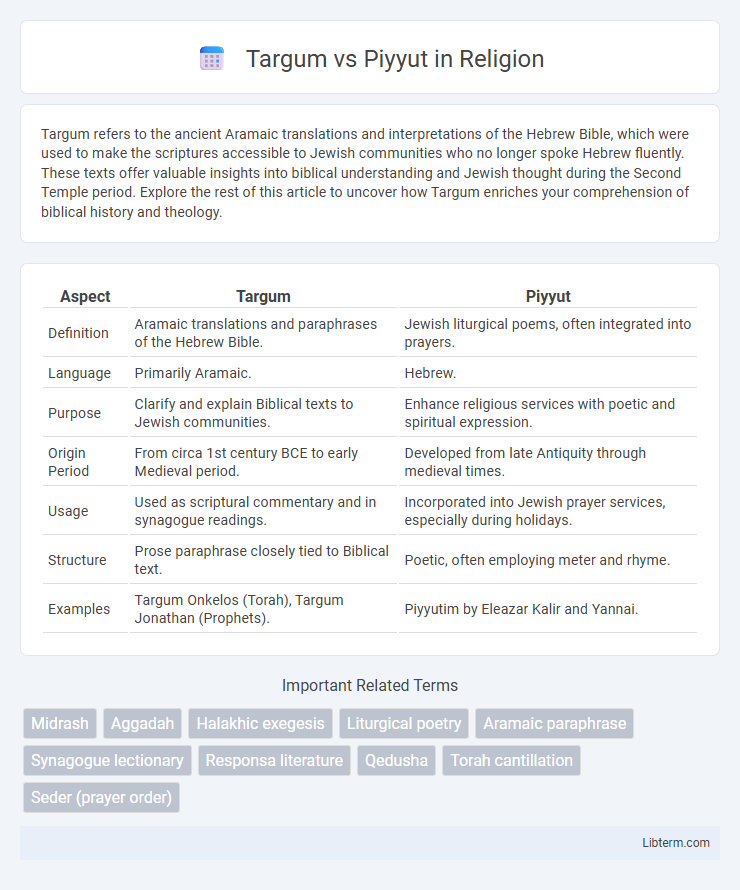Targum refers to the ancient Aramaic translations and interpretations of the Hebrew Bible, which were used to make the scriptures accessible to Jewish communities who no longer spoke Hebrew fluently. These texts offer valuable insights into biblical understanding and Jewish thought during the Second Temple period. Explore the rest of this article to uncover how Targum enriches your comprehension of biblical history and theology.
Table of Comparison
| Aspect | Targum | Piyyut |
|---|---|---|
| Definition | Aramaic translations and paraphrases of the Hebrew Bible. | Jewish liturgical poems, often integrated into prayers. |
| Language | Primarily Aramaic. | Hebrew. |
| Purpose | Clarify and explain Biblical texts to Jewish communities. | Enhance religious services with poetic and spiritual expression. |
| Origin Period | From circa 1st century BCE to early Medieval period. | Developed from late Antiquity through medieval times. |
| Usage | Used as scriptural commentary and in synagogue readings. | Incorporated into Jewish prayer services, especially during holidays. |
| Structure | Prose paraphrase closely tied to Biblical text. | Poetic, often employing meter and rhyme. |
| Examples | Targum Onkelos (Torah), Targum Jonathan (Prophets). | Piyyutim by Eleazar Kalir and Yannai. |
Introduction to Targum and Piyyut
Targum refers to the ancient Aramaic translations and interpretations of the Hebrew Bible, essential for understanding biblical texts within Jewish tradition. Piyyut consists of liturgical poems composed in Hebrew or Aramaic, enriching Jewish prayer with theological themes and poetic expressions. Both forms play a crucial role in Jewish religious life, with Targum facilitating scriptural comprehension and Piyyut enhancing worship through poetic devotion.
Historical Origins and Development
Targum, originating in the early centuries CE, served as an Aramaic translation and explanation of Hebrew scriptures to aid Jewish communities during the Second Temple period and beyond. Piyyut, emerging in late antiquity around the 5th to 7th centuries CE, developed as liturgical Hebrew poetry used primarily in synagogue worship, reflecting regional influences from Palestine and Babylonia. While Targum focused on scriptural interpretation and accessibility, Piyyut evolved to enhance religious expression and communal prayer through intricate poetic forms.
Linguistic Features and Styles
Targum features Aramaic translations of Hebrew biblical texts with a simple, explanatory style emphasizing clarity and oral comprehension, often employing paraphrasis and idiomatic expressions. Piyyut showcases intricate Hebrew poetic structures, utilizing parallelism, acrostics, and rich biblical allusions to create liturgical hymns that evoke emotional and spiritual resonance. The linguistic contrast highlights Targum's functional adaptation for understanding scripture and Piyyut's artistic framework aimed at enhancing worship experience.
Purpose and Function in Jewish Tradition
Targum serves as an Aramaic translation and interpretation of Hebrew Scriptures, enabling comprehension of sacred texts for Jewish communities speaking Aramaic, thus preserving religious teachings and facilitating study. Piyyut consists of liturgical poems incorporated into synagogue services, enhancing spiritual experience and expressing communal devotion through poetic and musical forms. Both play crucial roles in Jewish tradition by bridging textual understanding and worship expression, fulfilling distinct yet complementary religious functions.
Targum: Types and Notable Examples
Targum refers to ancient Aramaic translations and paraphrases of the Hebrew Bible, primarily designed to make scripture accessible to Jews who no longer understood Hebrew. Key types of Targum include Targum Onkelos on the Torah, renowned for its literal translation approach, and Targum Jonathan on the Prophets, offering interpretative expansions that clarify biblical narratives. Notable examples also encompass Targum Yerushalmi, which provides a more expansive and homiletic interpretation, reflecting the linguistic and cultural context of early Jewish communities.
Piyyut: Forms and Famous Compositions
Piyyut, an integral genre of Jewish liturgical poetry, encompasses various forms such as kinnot (lamentations), selichot (penitential poems), and piyyutim for Sabbath and festivals, each designed to enhance communal prayer and spiritual reflection. Famous compositions include the "Adon Olam," a timeless hymn expressing God's eternal sovereignty, and "Yigdal," a poetic summary of Maimonides' thirteen principles of faith, both of which remain central in Jewish worship. These works demonstrate the richness of Piyyut, blending biblical imagery with rabbinic themes, and highlighting its role in shaping Jewish liturgical traditions.
Role in Liturgy and Synagogue Life
Targum serves as an essential translation and interpretation of Hebrew Scriptures, enabling congregants to understand biblical texts during synagogue services and enhancing communal prayer experiences. Piyyut, a liturgical poem incorporated into prayers, enriches worship with poetic and theological depth, often reflecting seasonal themes or specific religious occasions. Both Targum and Piyyut play pivotal roles in shaping the spiritual atmosphere of the synagogue by facilitating engagement with sacred texts and fostering collective religious expression.
Interpretative Approaches and Theological Themes
Targum emphasizes literal and contextual translation of Hebrew Scriptures, preserving traditional interpretations with a focus on law and covenantal themes, often serving as a bridge for Aramaic-speaking communities. Piyyut employs poetic and liturgical creativity to expand upon biblical narratives, incorporating mystical and ethical dimensions that enhance communal worship and theological reflection. Both interpretative approaches reveal distinct theological themes: Targum upholds scriptural authority and historical continuity, while Piyyut highlights divine immanence and spiritual experience within Jewish prayer.
Influence on Later Jewish Literature
Targumim significantly shaped later Jewish literature by providing Aramaic translations and interpretations of the Hebrew Bible, influencing Talmudic discourse and Midrashic exegesis. Piyyutim contributed to Jewish liturgical poetry, enriching the synagogue service with complex theological themes and poetic forms that inspired subsequent Hebrew poetic developments. Both genres deeply impacted the evolution of Jewish textual tradition by intertwining scriptural understanding with creative expression.
Comparative Analysis: Targum vs. Piyyut
Targum and Piyyut represent distinct genres within Jewish textual traditions, with Targum serving as Aramaic translations and interpretative expansions of the Hebrew Bible, while Piyyut comprises liturgical poetry composed mainly in Hebrew, designed for synagogue worship. Targum emphasizes clarifying scripture through paraphrase and explanation, often reflecting rabbinic interpretation, whereas Piyyut enhances prayer experiences by incorporating poetic structure, rhyme, and thematic embellishment focused on praising God and commemorating religious events. The comparative analysis underscores Targum's role in scriptural accessibility and exegetical insight, contrasting with Piyyut's artistic and liturgical function within communal worship.
Targum Infographic

 libterm.com
libterm.com